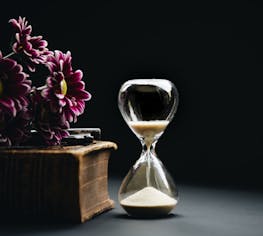What do you want to be when you grow up? If you're still not sure, fear not. Most "grown-ups" have yet to answer this perennial question. Why? Because there's no simple answer.
Designing Your Life, teaches us how to tinker with design tools, and apply them to our own lives, in order to work out and actualize our deepest desires. It shares real-life stories and strategies, such as reframing, prototyping, and mind-mapping, to help tackle our most important design project - our own life.
According to Silicon Valley design innovators, Bill Burnett and Dave Evans, there's more' aliveness in us for one lifetime.' We could walk several different life paths and likely feel perfectly happy and productive. To help us narrow down our options, they co-created the ultra-successful Life Design course at Stanford, as a tool to navigate life. Tried and tested by students, mid-career professionals and retirees, design thinking can help us find work and live a life that's both passion-filled and purpose-driven.
Bill Burnett is the executive director and co-creator of the design program at Stanford. He's worked on projects ranging from award-winning Apple powerbooks, to the original Star Wars action figures. Co-author Dave Evans is the co-director of the Stanford life design lab, and holds a master's in mechanical engineering from Stanford. He's also worked for Apple, where he introduced the computer mouse to the world, and co-founded Electronic Arts. Their mission is to help us find and pursue our life design. They do this by teaching us how to think and act like a designer. They believe a well-designed life, is a well-lived life.
We'll briefly examine why design thinking applies to life planning, why it's crucial to find coherence between what we believe and what we do, and how we can map out more than one path.
Happiness Comes from Designing a Life that Works for Us
The problem is we don't always believe this. We hold dysfunctional beliefs that prevent us from finding the career and life we want. We think our degree determines our career, or that a high-paying successful career will make us happy. And if we're not happy, we fear it's too late in life to make a significant change.
Take Ellen as an example. Ellen went to a prestigious university and graduated as a geologist. She chose geology because she enjoyed collecting and categorizing rocks. But only after graduating, did she realize that she didn't enjoy the other components that were part and parcel of her chosen career. With a degree in hand, she now had no idea how to get another job, or what she really wanted to do with the rest of her life.
What makes this story relevant is that Ellen's not alone in not wanting to work in the field that she majored in. Did you know that three-quarters of college graduates don't end up working in careers related to their majors? The belief that what we happen to "major in" is what we'll do for the rest of our lives is a dysfunctional one. It prevents us from taking time to pause, stand back, and design the life we want.
We also tend to believe that if we're successful, we'll be happy. Janine, a lawyer in her mid-30's, ticked all of her career and work-life goals. She had a degree, a good marriage, and a job at a prestigious law firm. However, in the evenings, she would find herself crying on her porch. She had everything she thought she should have, everything she thought that she wanted, yet she was profoundly unhappy. Janine's life was the picture of success from the outside, yet she felt that something was missing. Just like Ellen, Janine isn't alone. In America, two-thirds of workers are unhappy in their jobs, and 15% intensely dislike their work. So success doesn't determine our happiness.
In the United States alone, just over 31 million people between ages 44 and 70, desire what's referred to as an "encore" career. An encore career is work that combines personal meaning, continued income, and social impact. Some of those "31 million" have found their encore careers, but many others, like Ellen and Janine, have no idea where to begin, and fear it's too late in life to make a significant change.
Here's the good news—it's never too late to design the life you love. But we do need to get off the bench.
Designers Aren't Benchwarmers
Before we can design our lives, we need to think like a designer. There are few simple ways to do this, but first, there's one thing we need to understand: designers don't think their way forward. Instead, they build their way forward. We can conjure up all the plans in the world, but at the end of the day, they're just fun fantasies that have no relationship to the real world or who we really are. So to be a designer, we need to have a "bias towards action."
A bias towards action means, no sitting on the bench and thinking about what we want to do; we have to get into the game.
Designers create prototype after prototype; they often fail a few times before finding what works and what solves the problem. Why is this process necessary? It's important because frequently, the problem we genuinely need to solve, is entirely different from what we first imagine it to be. So we need to welcome failure, embrace change, and not be attached to outcomes. We also need to understand that things will get messy— but unique designs emerge from mess. If designers hadn't made mistakes, we'd exist in a world without the slinky, Teflon, Super Glue, and play-doh. If we're going to put our designer hats on, we're going to have to get curious, build things, try stuff, and have fun in the process. However, to stay grounded in the game, we have to remember that we're not alone. Design is a collaborative process. We need to reach out to others, know the right questions to ask, acquire mentors, and develop a supportive community around us to help us design our lives.
We can start by drawing upon the design thinking support from our authors. Here are several "thought experiments" from the book to help us design our way forward.
Take Stock and Connect the Dots
What do you want out of life?
The number one response students give our authors is this: 'for my life to be meaningful.' We all want our lives to be purposeful and to add up to something.
In response to this need, the authors turned to positive psychology and design literature. As it turns out, there are three things worth considering: there's who we are, what we believe, and that's what we do in the world. If we can connect these dots and find a more coherent balance between what we believe and do, we'll likely experience a greater sense of meaning.
So how do we play connect-the-dots? Try this exercise. Take out a piece of paper and write down your work view in no more than 250 words. Ask yourself, what's your theory of work? Not the job you want, but why do you work? And what's work in service of? Once you've done that, the next step is a little harder. Write down your life view. Why do you believe you're here, what's your faith or your view of the world, and what values do you hold close?
When we can connect our work-view and life view coherently, we start to experience a greater sense of meaning. Taking both pictures into consideration, offers us a compass to help us design our lives, stay the course, and adjust when necessary.
Another Clue to Finding Our Way is by Tapping into Our Energy Levels
Have you ever been so engaged and energized by what you're doing, that time seems to stop? That's called flow. Like meaning, moments of flow nourish our wellbeing.
Let's take the story of a civil engineer, Michael. Michael requested some life-design help from our authors. He hated his job and needed a change, and his family suggested that he pursue an MBA and go into finance. Burnett and Evans recommended a little journal exercise. Michael was told to reflect on his day, and find out when he was excited, focused, having a good time at work, and write down exactly what he was doing during those times. He did this for three weeks.
Michael reached a startling conclusion: he actually loved his job as a civil engineer. He felt most energized when he was working on complex engineering problems. What drained him and made him miserable was when he had to deal with difficult personalities, and perform administrative tasks—none of which have anything to do with engineering intricacies. After discovering what he specifically enjoyed, and what caused his energy to rise and fall, Michael decided to enter a Ph.D. program. He is now a high-level civil structural engineer, who spends his time working, mostly alone, on complex engineering problems. This makes him happy, and he's become so technically valuable that nobody asks him to do the administrative stuff anymore. Perhaps if it wasn't for this one simple exercise, Michael might have enrolled in an expensive business school. This would likely have led to a career involving more administrative people-related tasks.
Understanding what helps us stay energized and focused, allows us to make the most of our days, and offers us useful clues to enable us to design our lives.
So, How Many Lives Do You Have?
The single most prominent belief we need to debunk is that we have just one calling in life. It's the narrow idea that if we haven't found "the one"— our so-called passion, we're doomed to a life of misery. But here's the truth: there are several different lives we could lead from this point forward, and feel perfectly happy. From years of teaching this course, our authors say most people have about seven and a half really good lives that they could lead.
To keep things simple, start by exploring just three possibilities of "the good life" that we could grow into over the next five years. Our authors label these as follows: the optimized life, the alternative life, and the wildcard life.
Imagine walking into a movie theatre and watching these three different versions of our lives play out. The first show is our optimized life. It's basically the best plan for our life now. It's us ticking off personal and professional bucket list items over the next five years. While this might be a great show, there's just one problem, what if robots take over and that job doesn't exist anymore? Then what are we going to do? Time to come up with an alternative life plan. What industry could we transfer our skills to and work in, and what kind of lifestyle could still provide meaning and energize us over the next five years?
Now walk into the third movie theatre and watch our "third life" unfold over the next five years. This is the "wildcard plan." What would we do if we didn't have to worry about money, or that someone would laugh at such an idea? In other words, how would our life unfold over the next five years if money and "image" was off the cards?
This kind of thought experiment is called Odyssey planning. Our authors say that 'It's based on the idea there are many designs for our life, all filled with hope for the kind of creative and unfolding reality that makes life worth living.'
So now that we've brainstormed some ideas, time for execution, right? Not so fast; that's not how the design process works; after ideation comes the prototype stage.
Prototype Your Way Forward
Now it's time to validate and verify our designs. There are two kinds of life design prototypes: the prototype conversation, and the prototype experience.
William Gibson, the science fiction writer, famously said: ‘The future is already here, It's just unevenly distributed.' This means that there's a strong likelihood that someone out there, is living at least one of these three lives, and has been doing so for years. In other words, they're living our future today. All we have to do is to meet them, and ask them for their story. If nerves strike, just remember, people like to tell their stories, especially over a free coffee or lunch. Hear their story, and see if something resonates.
The other one is a prototype that relies on experience. Our authors call it the "toe-dip exercise." They worked with a woman in her mid-forties, who was a very successful executive at a tech company. However, she wanted to move from "money-making" to "meaning-making." She was contemplating returning to her student days, and pursuing a master's in education so she could work with kids. But at forty-five, the thought of returning to first-year studies (alongside millennials) was daunting. But true to the "try stuff" mentality, she decided to dip her toe in student life. The result was that she found the experience exhilarating. She sat down and found her body was on fire from all the fascinating content. She also sat alongside millennials, who turned out to be non-judgemental and exciting people. So she decided, at forty-five, to go back to school.
According to our authors, we're more than just our thoughts. So it's essential to seek out a felt experience that offers an embodied way to test our assumptions and design our way forward.
In Conclusion
Most of us don't know what we want to be when we "grow up." And that's a good thing.
Why would we ever want to stop "growing up"? Life is about growth and change, it's not static, and it's not some destination. We'll never be "done" with answering life's big questions "once and for all." So what if we hold close our child-like wonder, and draw upon the design process to create an ever-changing life we love. We can be more intentional about how we view life and work, map out our ideas, test the waters before we jump, and return to our design board when we need to.
So, fellow traveler, rather than grow up, what is it that you'd like to grow into?




